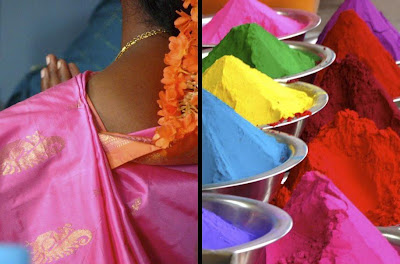Oh sweet dreams of exoticism! The photos of a friend who just came back from India give me a sudden desire of elsewhere. Now, I’m dreaming of sarees, spices and sandalwood…
But do we know, in Europe, perfumes from India? I do not speak about Indian-inspired ones, like Guerlain could do with Shalimar, Kenzo with Kenzo Amour Indian Holi or Francis Kurkdjian with Isvaraya from his brand Indult. No, I mean allying a perfume with the universe of an Indian creator. Because designers and Indian fashion grow steadily, and share with us universes of its own.
Of course, I immediately think about Manish Arora. There are obviously other Indian designers: traditional ones, such as Rohit Ball, promising young ones such as Rajesh Pratap Singh, Ritu Beri or Urvashi Kaur, and young accessories designers such as Shilpa Chavan. But Manish Arora gave a breath of eccentricity and modernity to the Indian fashion. A one of a kind universe, a little crazy, and pioneer in the Indian fashion design, which makes me smile every time I click on his website. He is the first who exported his fashion in Europe in 2003, and who took part in the London fashion show in 2005. He even appeared in the 3 Suisses catalog for an exclusive collection, distributed through direct sales.
And what if Manish Arora gets on with perfumes? Especially since he has already collaborated with the beauty industry by launching in 2008 an exclusive collection of MAC Cosmetics make-up, and by decorating in 2009 pots of Nivea cream, distributed in limited edition.
India is a fascinating country: at the same time rich in scents, colours and traditions, but also in a state of flux. When I figure its perfumes, I see rose petals, fresh spices, a blend of cardamom and curry, wet dirt tracks, the strong and lacteous notes of sandalwood shavings, smokes of incense… A colourful mosaic of perfumes, like the dance of sarees which dazzles the streets. The concept and the fragrance should follow these contemporary Indian artists, who manage to divert elements of traditional India, as Anita Dube has managed to do on her photos, with ceramics eyes, borrowed from the sculptures of Hindu divinities.
Of course, I immediately think about Manish Arora. There are obviously other Indian designers: traditional ones, such as Rohit Ball, promising young ones such as Rajesh Pratap Singh, Ritu Beri or Urvashi Kaur, and young accessories designers such as Shilpa Chavan. But Manish Arora gave a breath of eccentricity and modernity to the Indian fashion. A one of a kind universe, a little crazy, and pioneer in the Indian fashion design, which makes me smile every time I click on his website. He is the first who exported his fashion in Europe in 2003, and who took part in the London fashion show in 2005. He even appeared in the 3 Suisses catalog for an exclusive collection, distributed through direct sales.
And what if Manish Arora gets on with perfumes? Especially since he has already collaborated with the beauty industry by launching in 2008 an exclusive collection of MAC Cosmetics make-up, and by decorating in 2009 pots of Nivea cream, distributed in limited edition.
India is a fascinating country: at the same time rich in scents, colours and traditions, but also in a state of flux. When I figure its perfumes, I see rose petals, fresh spices, a blend of cardamom and curry, wet dirt tracks, the strong and lacteous notes of sandalwood shavings, smokes of incense… A colourful mosaic of perfumes, like the dance of sarees which dazzles the streets. The concept and the fragrance should follow these contemporary Indian artists, who manage to divert elements of traditional India, as Anita Dube has managed to do on her photos, with ceramics eyes, borrowed from the sculptures of Hindu divinities.
 Photos: Laure Lapeyronnie ("Bombay Maximum City" exhibition, Tri Postal, Lille, 2006)
Photos: Laure Lapeyronnie ("Bombay Maximum City" exhibition, Tri Postal, Lille, 2006) Moreover, Manish Arora has already shown through his fashion shows he was an amateur of diversion. So, a coloured and daring fragrance would be necessary! Two key words to associate with the designer universe.
Incense sticks may judiciously fill the range and allow it to integrate decoration and furniture distribution networks, for a differentiating strategy. In any case, do not miss the exhibition 'Autres maîtres de l'Inde', from March 2010 at the Quai Branly, about Indian craft industry. As for me, I will still linger in my Bollywood dreams, between silky drapes, sequins and pieces of soft cashmere…
Incense sticks may judiciously fill the range and allow it to integrate decoration and furniture distribution networks, for a differentiating strategy. In any case, do not miss the exhibition 'Autres maîtres de l'Inde', from March 2010 at the Quai Branly, about Indian craft industry. As for me, I will still linger in my Bollywood dreams, between silky drapes, sequins and pieces of soft cashmere…



No comments:
Post a Comment